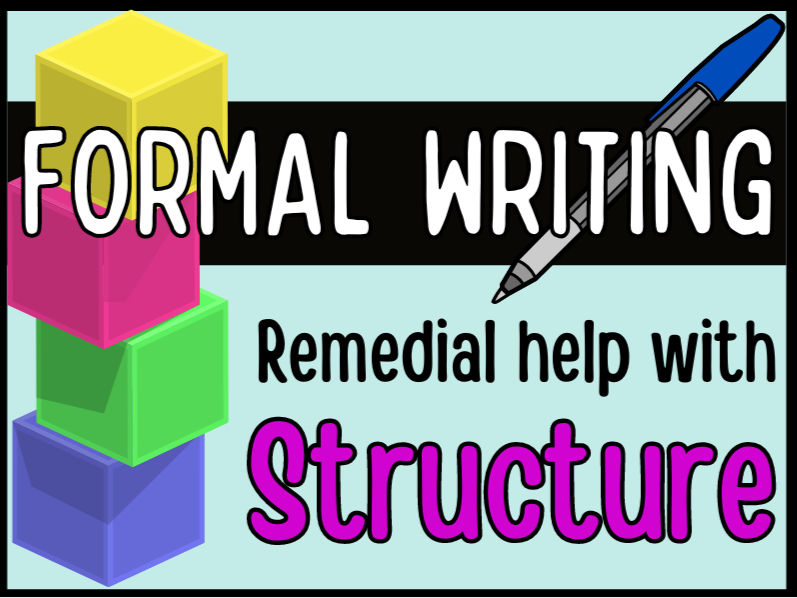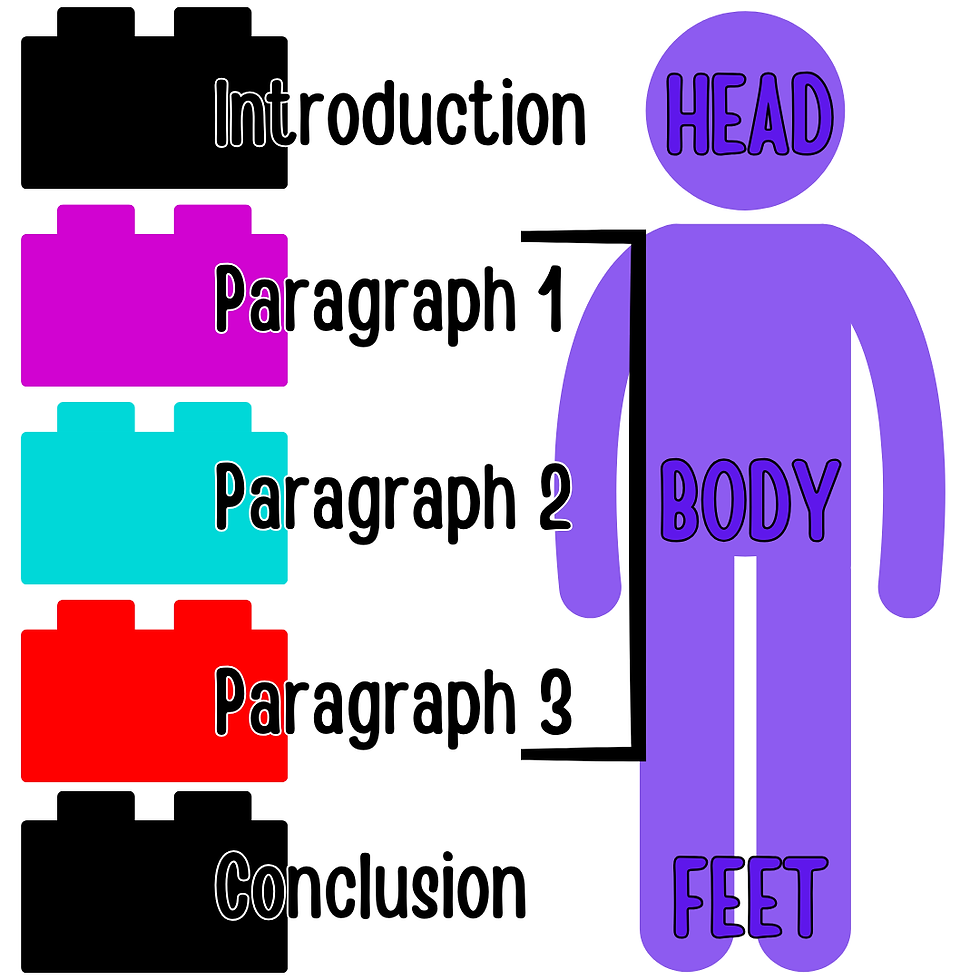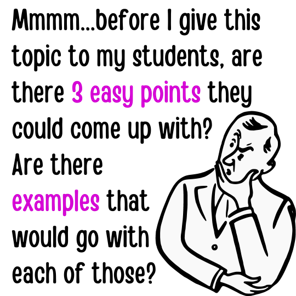
Teaching the basics of formal writing structure means stripping it back to what you’ll think are beyond the obvious. What seems common sense to us might not be to that struggling student. For example:
I know a student who can't tell the difference between an example and an explanation.
How many students have you seen writing (or typing) one paragraph straight under the other, without missing a whole line between the two.
Starting at the beginning is the only way to help students who need remedial work with formal writing structure. These could be your beginners or your most intelligent senior students who seem to have missed a few memos about structure over the years.
I didn’t understand a basic essay format until I began teaching and had to think about what a good essay would look like. Yes, I waffled my way through university. (Whaddaya know? Cs really do get degrees!) But that’s why I get the need to start with the basics.
As you work through this process, aim to kit students out with notes/worksheets glued into their books.

As you work through this process, aim to kit students out with notes/worksheets glued into their books. That way they can sit their exercise books beside them later when it’s time to write an essay. They have something to REFER to. Also, those notes can be seen in their entirety. If you load them onto Google Classroom, for example, they must scroll around the page to see them (their screens are TINY) , which adds a challenge these students just do NOT need! It also means having to toggle back and forth between your doc and their essay. That’s SO HARD. Give them printed/copied notes to refer to in their exercise books! So, here we go:
1. Go over the basic format
If nobody has ever shown students the building blocks of an essay, then what happens if they don’t just pick it up themselves? Primary/intermediate teachers might assume that’s covered at high school. By the time students get to year 9 though, high school teachers assume it’s been explained at primary/intermediate. How many students fall down that crack?!


Explain:
They’ll write five paragraphs. You might even need to explain that these are ‘blocks’ of writing.
That the five 'blocks' include: the introduction, paragraph 1, paragraph 2, paragraph 3, the conclusion. (See graphic above.)
Compare this building block structure with a body. Why? Because we call those three paragraphs in the middle the ‘body’ of the essay. Help them see:
The introduction as the head.
The three paragraphs in the middle as the body.
The conclusion as the feet.
It’d be stink to be without a head, body or your feet. It’d be stink to have your formal writing missing those too!
That each ‘block’/paragraph is separated by a missed line. This means, if you’re typing, you’ll hit the enter key twice. (See graphic above right.)
Emphasise as you go that they won’t know what an introduction, nor conclusion is yet and that that’s okay. We’re not worrying about that yet!
2. PRACTICE – making 3 points about basic topics.
Choose your topics carefully – think of ones that you and the students can easily think of three quite different and clear points about. You could choose:
A why topic. Eg: Why boys are better than girls (or vice versa) or Why it’s great/terrible to be an only child.
A how topic. Eg: How to keep organised. How to be happy on a Monday.
Three things about a subject. Eg: Three ways you can help save the planet. Three reasons to avoid picking your nose in public.
Plan some points as part of your planning. It’s a pain in the neck to pop a topic on the whiteboard to brainstorm points about…only to find that topic doesn’t easily lend itself to the activity. Remember, it’s not about having students learn to think, it’s about getting them through this basic structure, so it’s okay for the topic to be super simple and certainly to ham it up a bit.
3. Zoom in on paragraphs
Most of us probably use acronyms such as:
SEE or SEX – statement, explanation, example (and for seniors SEXE – statement, explanation, example, evaluation)
TEE or TEX – topic explanation, example
I’m a fan of PEE – I like telling the toilet humour of peeing on the page. Three times!
Beware your vocabulary!
Use the words statement, topic or point, but do NOT call them ideas. This can confuse students when you discuss the ideas of a text (ie, main idea – message). Remember, we’re keeping things super simple so that students can just focus on learning that structure.
Use the word example, not evidence – at this stage anyway.
Use Lego (or Cuisenaire rods or make coloured cards…) to show the structure of the whole essay as well as the structure of each paragraph. Use the connotations of colour to have your visual humming. Eg:
I like to use a different colour for each point.
Red for the example (because they are IMPORTANT).
Yellow for the explanation (bright ideas/thoughts).

4. Get rid of the explanation for now – focus on examples
Tell students you’re going to strip paragraphs down to just a point and an example first. If you’re using a visual (highly recommended) like my Lego, stand in front of the class and remove the yellow piece (explanation) from each paragraph. Make a show of it so they can understand VISUALLY what's going on.
Because students who struggle with formal writing are often unsure of what an example is, teach them this first. I keep it simple. An example can be:
Something you’ve copied (eg: a non-fiction text, a story). I insist on the double quotation marks.
Something you’ve described (eg: paraphrasing from a non-fiction text, something that happened to a character in your story).
5. Meaning of introduction and conclusion
Go over the definition of ‘introduction’ – eg: we introduce a new person so that others know what to expect. So, your reader is going to get to know your writing, and know what to expect, when you list the three points you’re going to discuss.
Go over the definition of ‘conclusion’ – eg: your brother’s fingerprints are all over the empty biscuit box, his face is covered in chocolate…what conclusion can you come to? Bro is bad! Or, a bit more likely: cats are better pets than dogs because of x, y and z, so I can conclude that cats would be a fine choice for your next family pet.
Do NOT let students get into the habit of writing In conclusion… My English teacher in form 4 told me, “Sue, you don’t need to say I am writing to request… It’s obvious you are writing. Just get straight to the point.” The same argument applies to In conclusion… It should be obvious this is the conclusion because it’s the last paragraph, and the reader will be able to tell it’s a conclusion by what is said.
6. Give students examples of the type of formal writing you want them to do
This is where you’ll introduce students to that other part of the paragraph – the explanation.
This is where you’ll introduce students to that other part of the paragraph – the explanation. You could give them:
1. A piece of formal writing that YOU’VE already annotated.
2. A second piece (different) ‘clean’ piece that that you’ll annotate as a class.
3. A third (different again) piece to annotate with a mate/on their own. Mark their work!
Ensure these are glued into their books!
The beauty of this activity is that you’re writing these essays. This will help you empathise with students and understand better some of the pickles they might get into. Keep them SHORT – three sentences per paragraph! Remember to make a plan for the next step too – read on...!
7. Introduce planning
Show students your plan. Your plan should include:
Point 1 + example for that point.
Point 2 + example for that point.
Point 3 + example for that point.
I‘m a fan of setting this out in a table because I’ll use a table to scaffold students’ own planning later. (It’s so much less threatening for students if they can just fill in the blank table. Nobody likes to be faced with a blank page!)
Return to the topics you all looked at for step 2 above. Have students write their plans. Have them work in pairs if you like, but ensure they each have a copy...which they'll glue into their books of course!
8. Begin writing – one…body…paragraph…at…a…time
Give students a basic topic – I’d reuse one they’ve already looked at for step 2.
Students complete their lovely scaffoldy planning template first! It should show their:
Points
An example for each point.
You must check this.
Next, begin with a body paragraph. Students have their annotated examples to refer to as they write. Have them write a paragraph a day, perhaps – point, example, explanation. YOU write too, but use a different topic, writing on the board as they work on their own paragraphs. They’ll look up every now and again and see you working through the process, ‘struggling’ too. Stick your plan on the board so that students can come and look at it.
Oh, and tell your students the explanation can come before and/or after their example. It doesn’t matter about the order there – it’s whatever sounds ‘right’.
Mark students' paragraphs before they go onto the next one. You don’t want them going down the garden path with that first one, then repeating the same mistake another two times.
Tip: You gave them a ‘fill in the gap’ scaffold to plan on, why not do the same for their paragraphs?
9. Introduction and conclusion
Give these a crack next. I’d focus on the introduction on one day, the conclusion on the next day. They don’t need to take up the whole lesson. Break this essay writing up a bit with something else (eg: get onto your speech practice or static image). Remember, ban In conclusion!

Final tip:
If you’re studying a short text that you expect students to write an essay about, choose your story carefully! The Sniper by Liam O’Flaherty is difficult to write about. My favourite short story of all time, Patricia Grace’s “Beans” can be difficult to write an essay about. Find something where students can write about ‘3 things’. The same goes for expository essay topics. Ensure there are ‘3 things’ solid and different things that students can write about. Now, go tackle those year 13s! Hehe!

.png)
_edited.png)















_edited.png)
Comments